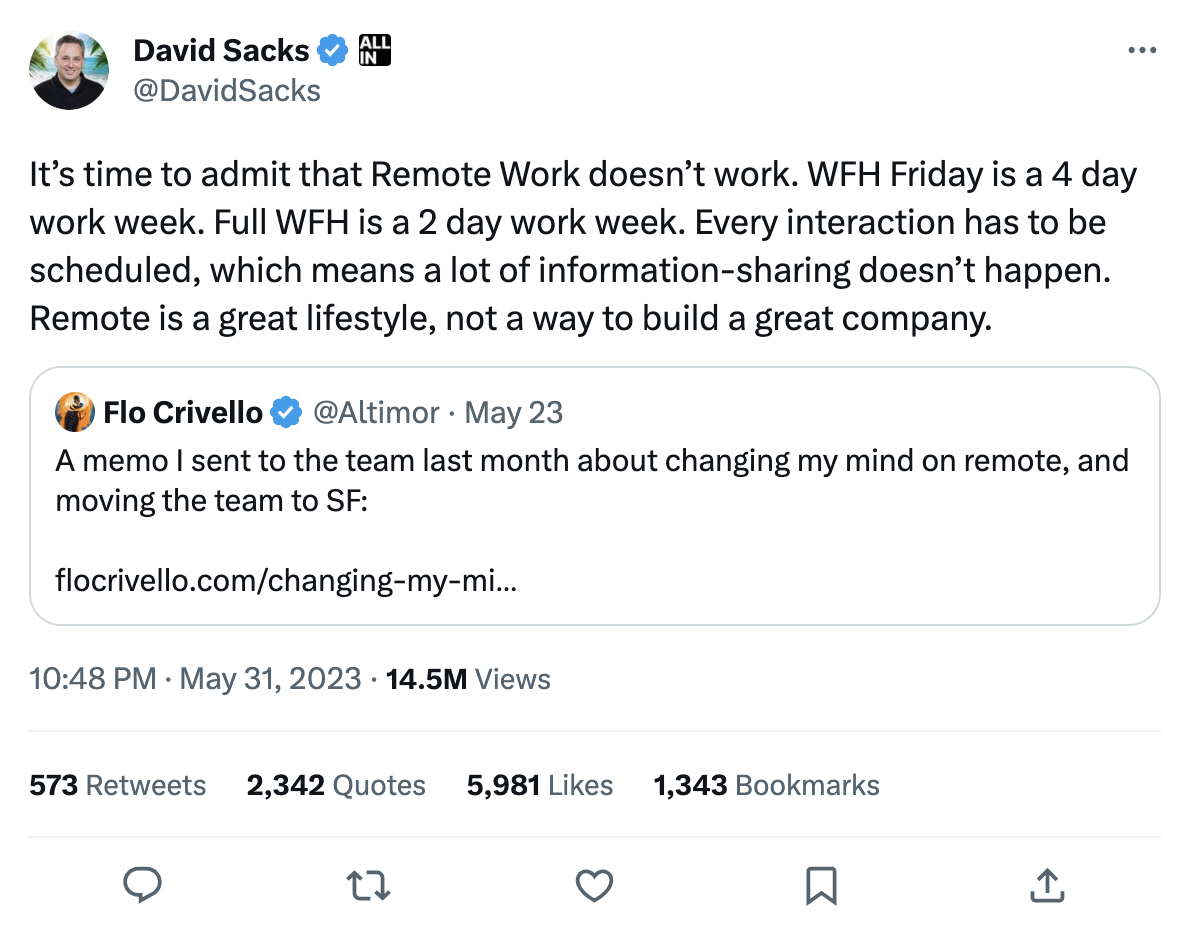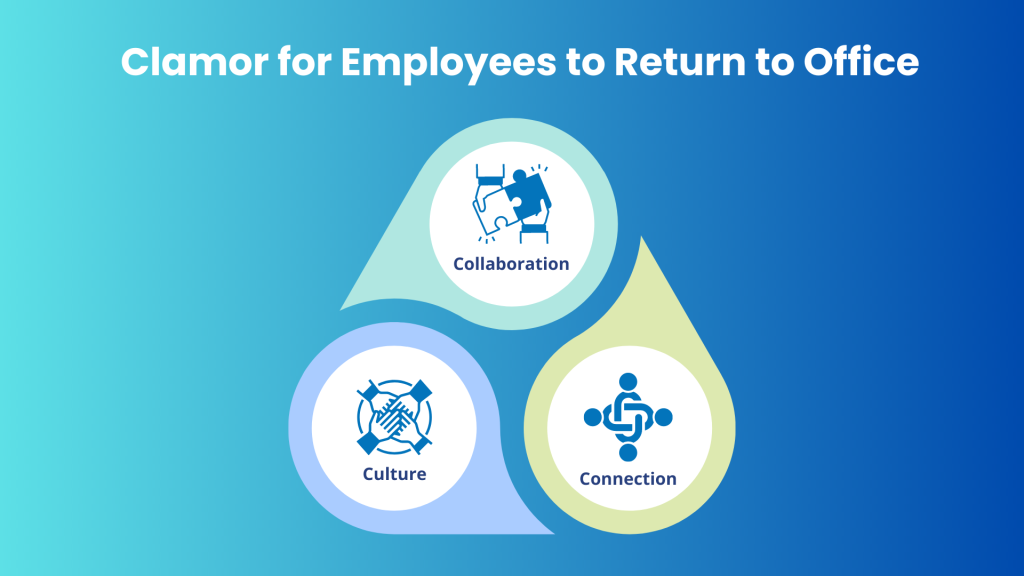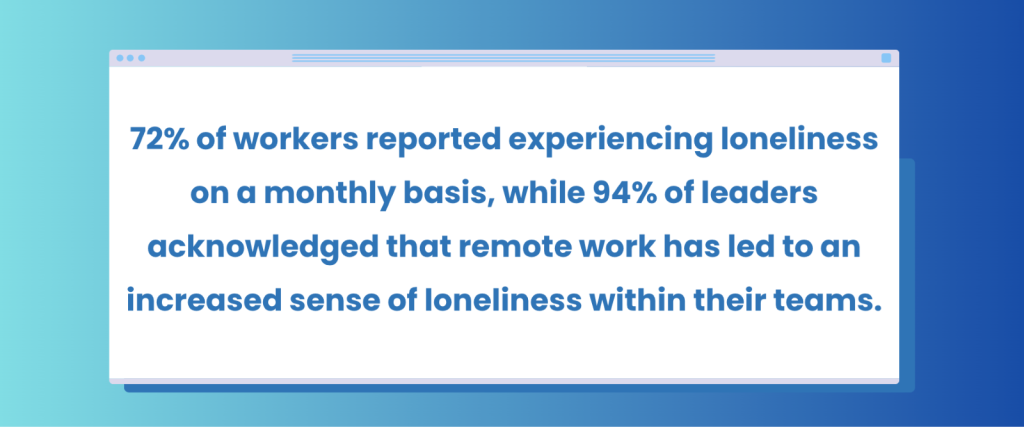Context
The pandemic brought about numerous changes, and now various aspects are gradually returning to normal. However, one area that continues to be significantly affected is the workplace. The fundamental nature of how we work has undergone a profound transformation since the pandemic. Employees prefer to work from home or remotely while visiting the office on purpose once in a while. Just as it seemed the model was settling in, a vigorous debate has arisen among entrepreneurs, venture capitalists, and leaders regarding the future of work. The world appears to be divided between those who believe it’s time for employees to return to the office and advocates of remote working. This blog explores the advantages of both approaches and proposes a possible path forward.
Clamor for Employees to Return to Office

Renowned venture capitalist David Sacks (@DavidSacks) recently posted the following statement on his Twitter account (screenshot attached). This message generated a significant reaction both in favor of and against his viewpoint. Similar view was expressed by Paul Graham (@PaulG), well-known computer scientist, VC and entrepreneur, who emphasized that while there will be some remote-first companies, remote-first won’t be a default (mode of operation). (screenshot attached)

When one analyses the reasons why employers are keen to have employees back in the office, 3 C’s stand out.

Collaboration
Employees often highlight collaboration as the primary motivation for wanting to work from the office. This encompasses not only face-to-face meetings and brainstorming sessions but also the ability to solve problems together. While remote setups can facilitate such activities, they tend to be more efficient and effective when conducted in person. A significant amount of information sharing occurs through brief, informal conversations that take place naturally throughout a regular workday. In a remote setup, organizing and scheduling such sessions can be cumbersome and less spontaneous.
Culture
The culture of a company is ingrained not only through formal trainings but primarily through the interactions between employees. It is during these interactions that individuals observe and absorb how leaders handle different situations, how they treat their colleagues, the pace and priorities. However, many new hires in the past three years have had limited opportunities to visit the office to personally experience the company’s cultural values.
Connection
As social beings, humans thrive on interpersonal connections. According to a study featured in Harvard Business Review, face-to-face meetings have been found to be 34 times more effective than communicating through emails. Additionally, an often overlooked aspect is how in-person work contributes to alleviating loneliness. In a 2022 global survey, 72% of workers reported experiencing loneliness on a monthly basis, while 94% of leaders acknowledged that remote work has led to an increased sense of loneliness within their teams.

Demand for Remote Work Status Quo
Despite initial doubts, remote work, which became a necessity during the pandemic, proved to be successful. Companies matched or surpassed pre-pandemic productivity levels. Employees experienced a newfound work-life balance, and companies could tap into a global workforce while reducing real estate costs. It was a win-win arrangement.
However, a divide has emerged between the perceptions of employees and employers. According to the 2022 Microsoft Work Trend Index report, 87% of employees believe they are productive, whereas 85% of leaders find it challenging to have confidence in employee productivity under the shift to hybrid work (read remote work). Employees desire the autonomy to choose when and where they work, while employers are advocating for bringing employees back to the office at least for some days of the week, citing the aforementioned reasons.
Furthermore, different regions exhibit varying behaviours in this regard. Developed economies express a stronger demand for maintaining remote work setups compared to developing ones where many employees visit offices voluntarily without any mandate. This may be influenced by demographic and cultural factors.
In sum, employees do not wish to return to the office simply because their employers deem it necessary. Recent protests at Amazon have shown that mandates may not be effective in such cases.
Way Forward – Is Return to office inevitable?
We firmly believe that a one-size-fits-all approach is not suitable when it comes to workplace strategies, and each company should carefully determine their own journey. For startups, where success or failure may be determined within a limited timeframe, working together in person may prove more effective. On the other hand, many companies that have experienced positive outcomes from remote work and may choose to continue with that setup, possibly incorporating occasional offsite gatherings for team cohesion.
However, we believe that a large number of companies, supported by employees should embrace a hybrid work style, which allows them to benefit from the best of both worlds. These companies can provide employees with autonomy and encourage them to come to the office based on purpose rather than rigid mandates. It is essential to reimagine workplaces as spaces that foster collaboration, team building, and knowledge sharing, rather than focusing solely on regular work that can be accomplished from anywhere.
According to the Microsoft Work Trend survey, 84% of employees find motivation in the prospect of socializing with colleagues when working in person at the office. Therefore, companies should prioritize technology-enabled team coordination even before employees plan their visits to the office. We have observed significant interest in this approach and believe it will undoubtedly enhance voluntary office attendance.

Conclusion – Return to Office or Remote Work?
In summary, as post-pandemic workplaces continue to evolve, the hybrid work framework will inevitably differ across companies. Our conclusion is that remote work (WFH) is highly effective for established teams seeking work-life balance, streamlined collaboration with a limited group of colleagues, and focused task completion. On the other hand, working from the office (WFO) proves advantageous for aggressive, high-growth teams engaged in ideation, debates, training, and team building activities. We firmly believe that a combination of WFO and WFH will emerge as the prevailing approach in most workplaces. Therefore, our recommendation is for employers and employees to collaborate in defining the most appropriate technology-enabled model, taking into account their organization’s current and future needs, while ensuring alignment with the overarching goals of the enterprise.




